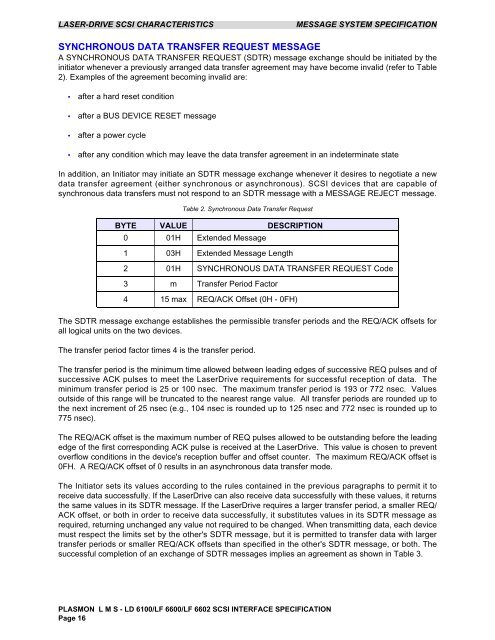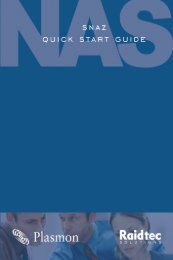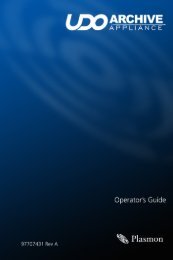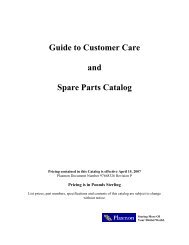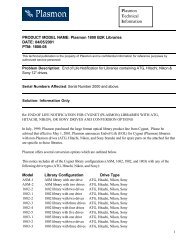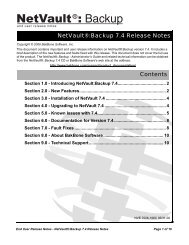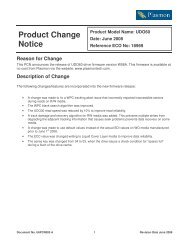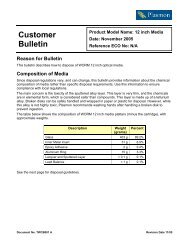scsi interface specification - Plasmon
scsi interface specification - Plasmon
scsi interface specification - Plasmon
You also want an ePaper? Increase the reach of your titles
YUMPU automatically turns print PDFs into web optimized ePapers that Google loves.
LASER-DRIVE SCSI CHARACTERISTICS MESSAGE SYSTEM SPECIFICATIONSYNCHRONOUS DATA TRANSFER REQUEST MESSAGEA SYNCHRONOUS DATA TRANSFER REQUEST (SDTR) message exchange should be initiated by theinitiator whenever a previously arranged data transfer agreement may have become invalid (refer to Table2). Examples of the agreement becoming invalid are:• after a hard reset condition• after a BUS DEVICE RESET message• after a power cycle• after any condition which may leave the data transfer agreement in an indeterminate stateIn addition, an Initiator may initiate an SDTR message exchange whenever it desires to negotiate a newdata transfer agreement (either synchronous or asynchronous). SCSI devices that are capable ofsynchronous data transfers must not respond to an SDTR message with a MESSAGE REJECT message.Table 2. Synchronous Data Transfer RequestBYTE VALUE DESCRIPTION0 01H Extended Message1 03H Extended Message Length2 01H SYNCHRONOUS DATA TRANSFER REQUEST Code3 m Transfer Period Factor4 15 max REQ/ACK Offset (0H - 0FH)The SDTR message exchange establishes the permissible transfer periods and the REQ/ACK offsets forall logical units on the two devices.The transfer period factor times 4 is the transfer period.The transfer period is the minimum time allowed between leading edges of successive REQ pulses and ofsuccessive ACK pulses to meet the LaserDrive requirements for successful reception of data. Theminimum transfer period is 25 or 100 nsec. The maximum transfer period is 193 or 772 nsec. Valuesoutside of this range will be truncated to the nearest range value. All transfer periods are rounded up tothe next increment of 25 nsec (e.g., 104 nsec is rounded up to 125 nsec and 772 nsec is rounded up to775 nsec).The REQ/ACK offset is the maximum number of REQ pulses allowed to be outstanding before the leadingedge of the first corresponding ACK pulse is received at the LaserDrive. This value is chosen to preventoverflow conditions in the device's reception buffer and offset counter. The maximum REQ/ACK offset is0FH. A REQ/ACK offset of 0 results in an asynchronous data transfer mode.The Initiator sets its values according to the rules contained in the previous paragraphs to permit it toreceive data successfully. If the LaserDrive can also receive data successfully with these values, it returnsthe same values in its SDTR message. If the LaserDrive requires a larger transfer period, a smaller REQ/ACK offset, or both in order to receive data successfully, it substitutes values in its SDTR message asrequired, returning unchanged any value not required to be changed. When transmitting data, each devicemust respect the limits set by the other's SDTR message, but it is permitted to transfer data with largertransfer periods or smaller REQ/ACK offsets than specified in the other's SDTR message, or both. Thesuccessful completion of an exchange of SDTR messages implies an agreement as shown in Table 3.PLASMON L M S - LD 6100/LF 6600/LF 6602 SCSI INTERFACE SPECIFICATIONPage 16


